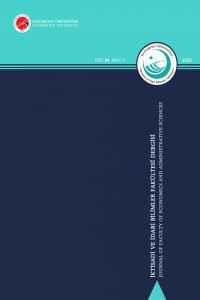Ekonomik Büyüme, Turizm ve Ticari Açıklık İlişkisi: Türkiye Örneği
Ekonomik Büyüme, Turizm, Ticari Açıklık
The Relationship Among Economic Growth, Tourism and Trade Openness: An Example of Turkiye
Economic Growth, Tourism, Trade Openness,
___
- Adamopoulos, A., & Thalassinos, E. I. (2020). Tourism Development and Economic Growth: A Comparative Study for the G-6 Leaders. European Research Studies Journal, 23(1), 368-380.
- Agaraj, X., & Murati, M. (2009). Tourism an important sector of economy development. Annals-Economy Series, 1, 83-90.
- Bozkurt, H. (2007). Zaman Serileri Analizi, Ankara: Ekin Kitapevi
- Dar, A., & Amirkhalkhali, S. (2003). On the impact of trade openness on growth: further evidence from OECD countries. Applied Economics, 35(16), 1761-1766.
- Durmuş, S., Şahin, D., & Beşcanlar, S. (2021). Gelişmekte Olan Ülkelerde Turizm Gelirleri, Doğrudan Yabancı Yatırımlar ve Ticari Açıklığın Ekonomik Büyüme Üzerine Etkisi. Karamanoğlu Mehmetbey Üniversitesi Sosyal ve Ekonomik Araştırmalar Dergisi, 23(41), 517-529.
- Gujarati, D. N. (2004). Basic Econometrics, New York City: The McGraw – Hill Companies.
- Güloğlu, B., & Altunoğlu, E. (2002). Finansal Serbestlesme Politikalari ve Finansal Krizler: Latin Amerika, Meksika, Asya ve Türkiye Krizleri. İstanbul Üniversitesi Siyasal Bilgiler Fakültesi Dergisi, (27), 107-134.
- Habibi, F., & Ahmadzadeh, K. (2015). Tourism development, trade openness and economic growth: The case of Malaysia. European Journal of Economics, Finance and Administrative Sciences, 78, 129-139.
- Jalil, A., Mahmood, T., & Idrees, M. (2013). Tourism–growth nexus in Pakistan: Evidence from ARDL bounds tests. Economic Modelling, 35, 185-191.
- Jenkıns, H. P., & Katırcıoglu, S. T. (2010). The bounds test approach for cointegration and causality between financial development, international trade and economic growth: the case of Cyprus. Applied Economics, 42(13), 1699-1707.
- Katircioglu, S. (2009). Tourism, trade and growth: the case of Cyprus. Applied Economics, 41(21), 2741-2750.
- Keho, Y. (2017). The impact of trade openness on economic growth: The case of Cote d’Ivoire. Cogent Economics & Finance, 5(1), 1332820.
- Krueger, A. O. (1980). Trade policy as an input to development, The American Economic Review, 70 (2), 288-292.
- Kulendran, N., & Wilson, K. (2000). Is there a relationship between international trade and international travel?, Applied Economics, 32(8), 1001-1009.
- Lee, C. G. (2012). Tourism, trade, and income: Evidence from Singapore. Anatolia, 23(3), 348-358.
- Leitão, N. C. (2010). Does trade help to explain tourism demand? The case of Portugal. Theoretical and Applied Economics, 63-74.
- Manga, M., & Balli, E. (2019). Turizm, Ekonomik Büyüme, Ticari Açıklık ve Finansal Gelişme Arasındaki İlişki: Türkiye Örneği. Finans Politik & Ekonomik Yorumlar, 56(647), 9-22.
- McKinnon, R. I. (1964). Foreign exchange constraints in economic development and efficient aid allocation. The Economic Journal, 74(294), 388-409.
- Pata, U. K. (2020). Turizm, Finansal Gelişme, Ticari Açıklık ve Sermaye Stokunun Ekonomik Büyüme Üzerindeki Etkileri: Türkiye Örneği. Çukurova Üniversitesi Sosyal Bilimler Enstitüsü Dergisi, 29(4), 151-167.
- Sevüktekin, M. ve Çınar, M. (2014). Ekonometrik Zaman Serileri Analizi. Bursa: Dora Basın – Yayın.
- Shi, H., & Smyth, R. (2012). Economies of scale in the Australian tourism industry. Applied Economics, 44(33), 4355-4367.
- Soyak, A. (2009). Türkiye’ye Yönelik Yabancı Turizmin İktisadi Etkileri: Akdeniz ve Ege Bölgeleri Üzerine Bir Araştırma, İstanbul: Der Yayınları.
- T.C. Turizm ve Kültür Bakanlığı (2022). Turizm İstatistikleri. Erişim Adresi: https://is.gd/hYB1dz
- TÜİK, (2014). İstatistiki Göstergeler 1923 – 2011, Ankara: Türkiye İstatistik Kurumu Matbaası.
- TÜİK, (2022). Eğitim, Kültür, Spor ve Turizm İstatistikleri. Erişim Adresi: https://is.gd/d1AEfR
- UNWTO, (2020). Covid-19 Response: 96% of Global Destinations Impose Travel Restrictions, UNWTO Reports. Madrid, İspanya. Erişim Adresi: https://www.unwto.org/news/covid-19-response-travel-restrictions
- UNWTO, (2021). The Economic Contribution of Tourism and the Impact of COVID-19, preliminary version, Madrid, İspanya. Erişim Adresi: https://doi.org/10.18111/9789284423200.
- World Bank (2022). World Development Indicators. Erişim Adresi: https://databank.worldbank.org/source/world-development-indicators.
- Yanikkaya, H. (2003). Trade openness and economic growth: a cross-country empirical investigation. Journal of Development Economics, 72(1), 57-89.
- Yayın Aralığı: Yılda 2 Sayı
- Başlangıç: 2013
- Yayıncı: Kastamonu Üniversitesi
Katılım Bankalarında Havuz Problemi
Türkiye Ekonomisi için Tasarruf–Yatırım İlişkisi üzerine Bir Araştırma
Gelir Eşitsizliği ve İnsani Gelişme İlişkisi: Türkiye Örneği
Etik Yaklaşımlar Açısından Sürdürülebilirliğin Ontolojik Çözümlemesi
Halil İbrahim AYDINLI, Bahar YOLVERMEZ
Destekleme Priminin Ayçiçeği Arzı Üzerindeki Etkisi: ARDL Modeli
Orhan ECEMİŞ, İlker İbrahim AVŞAR
Kadın ve Siyaset: Türkiye’de Hazırlanan Lisansüstü Tezler Üzerine Bir Araştırma
Avukatlık Ücretlerinin Vergilendirilmesinde Uygulamada Karşılaşılan Sorunlar ve Çözüm Önerileri
